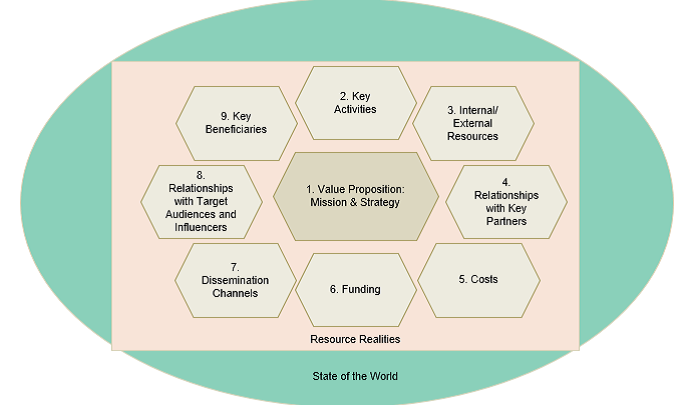Theory of the Foundation: The Philanthropy Canvas
March 23, 2018Rockefeller Philanthropy Advisors’ Theory of the Foundation initiative has launched its next phase with the publication of The Philanthropy Canvas.
Background on the Theory of the Foundation
The Theory of the Foundation initiative, undertaken in collaboration with dozens of philanthropic organizations and individuals as thought partners, created a framework for introspection that allows foundations to explore fundamental beliefs and assumptions about their work and about how they operate as organizations. Our aim is to stimulate a discussion about foundations as institutions, beyond programmatic or grantmaking activities, and help foundations more effectively align their purpose and resources for impact.
In the initial phase, we developed the Core Framework, which consists of a foundation’s charter, its social compact, and its operating capabilities. These elements taken together, we believe, inform a foundation’s structure and approach. For more insight on the core framework, see our publication produced in partnership with GrantCraft, Frameworks for Private Foundations: A New Model for Impact.
The Next Phase: The Philanthropy Canvas and Operating Models
We recently launched a new phase of the initiative, whereby we seek to:
- translate the Core Framework into operational models;
- undertake a deep exploration of what drives specific operating models; and
- suggest a useful tool—the “Philanthropy Canvas”—for aligning all elements of the model for mission, strategy and impact.
As the first step of this phase, we recently completed a working paper in order to engage members of our Learning Collaborative in exploring and further developing this working hypothesis.
This working paper, The Philanthropy Canvas: An Operating Model Representation for 21st Century Foundations explains the genesis of and describes The Philanthropy Canvas (pictured below). The Canvas is a visual model that invites foundation staff, trustees and other key stakeholders to map out the elements necessary to implement a foundation’s strategy in relationship to both its core framework and to the external environment that it seeks to influence and by which it is in turn influenced.

Understanding how the operating model of your foundation or program compares to similarly situated foundations or programs with similar goals can be a valuable exercise, highlighting areas for further analysis and potential change. Thus the canvas can be used as a tool for organizational planning and development, and viewed as a way of aligning the foundation’s operating capabilities and existing systems with its strategy and ambitions.
At the request of participants in our Learning Collaborative and based on feedback to-date , we’ve developed several identifiable operating model types. While this list is not exhaustive, and certainly not definitive, many programs and foundations fit into one of these six types.
Operating Model Types
- Campaign Manager
Believes that policy change is a fundamental tool for systemic change, and uses its institutional power – often in partnership with others – to get a policy or solution broadly adopted.
- Catalyst
Provides flexible funding to allow for new ideas to develop or come to fruition in ways that the foundation doesn’t try to foresee or manage. Instead, it maintains a hands-off approach that allows grantees to drive their own programming with the hopes that successes will bring others to the table.
- Field Builder
Focuses on creating a new set of institutions that will create a vibrant, powerful ecosystem for an issue or movement and therefore grows organizations and movements to reach the capacity for major impact.
- Talent Agency
Prioritizes betting on individual leaders or key organizations by selecting, strengthening and promoting leading change agents who are closest to the issue, with less attention on their programmatic goals or strategies and more on their potential.
- Think Tank
Applies its expertise to design internally policy or systemic solutions, “market” the approach, and then find implementers for those solutions.
- Real-Estate Developer
Convenes a diverse set of stakeholders or a consortium to implement a complex, time-intensive solution that generally crosses sectors and traditional program or issue areas.
By understanding their “type,” organizations may use this information to inform strategy and develop programs that are reflective of their strengths and capacity. As we continue to test our hypothesis, we are exploring additional models and identifying key considerations for the various types. With a number of convenings and research projects planned for the next year and beyond, our learnings will continue to evolve. For updates on Theory of the Foundation, please sign up for the RPA newsletter or check TheoryoftheFoundation.org.
As with every previous phase of our Theory of the Foundation initiative, we are grateful to every participant who contributed their time and expertise to furthering our mission of enhancing the capacity of foundations to align their resources for impact.
Back to News
